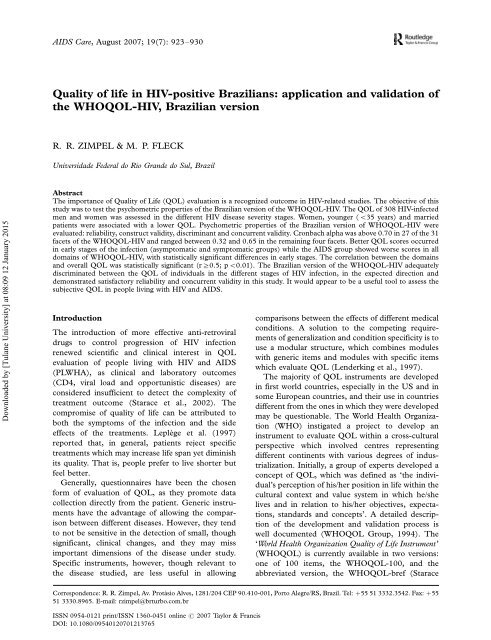WHOQOL-HIV (validação)
Create successful ePaper yourself
Turn your PDF publications into a flip-book with our unique Google optimized e-Paper software.
AIDS Care, August 2007; 19(7): 923930<br />
Quality of life in <strong>HIV</strong>-positive Brazilians: application and validation of<br />
the <strong>WHOQOL</strong>-<strong>HIV</strong>, Brazilian version<br />
R. R. ZIMPEL & M. P. FLECK<br />
Universidade Federal do Rio Grande do Sul, Brazil<br />
Downloaded by [Tulane University] at 08:09 12 January 2015<br />
Abstract<br />
The importance of Quality of Life (QOL) evaluation is a recognized outcome in <strong>HIV</strong>-related studies. The objective of this<br />
study was to test the psychometric properties of the Brazilian version of the <strong>WHOQOL</strong>-<strong>HIV</strong>. The QOL of 308 <strong>HIV</strong>-infected<br />
men and women was assessed in the different <strong>HIV</strong> disease severity stages. Women, younger (B35 years) and married<br />
patients were associated with a lower QOL. Psychometric properties of the Brazilian version of <strong>WHOQOL</strong>-<strong>HIV</strong> were<br />
evaluated: reliability, construct validity, discriminant and concurrent validity. Cronbach alpha was above 0.70 in 27 of the 31<br />
facets of the <strong>WHOQOL</strong>-<strong>HIV</strong> and ranged between 0.32 and 0.65 in the remaining four facets. Better QOL scores occurred<br />
in early stages of the infection (asymptomatic and symptomatic groups) while the AIDS group showed worse scores in all<br />
domains of <strong>WHOQOL</strong>-<strong>HIV</strong>, with statistically significant differences in early stages. The correlation between the domains<br />
and overall QOL was statistically significant (r]0.5; pB0.01). The Brazilian version of the <strong>WHOQOL</strong>-<strong>HIV</strong> adequately<br />
discriminated between the QOL of individuals in the different stages of <strong>HIV</strong> infection, in the expected direction and<br />
demonstrated satisfactory reliability and concurrent validity in this study. It would appear to be a useful tool to assess the<br />
subjective QOL in people living with <strong>HIV</strong> and AIDS.<br />
Introduction<br />
The introduction of more effective anti-retroviral<br />
drugs to control progression of <strong>HIV</strong> infection<br />
renewed scientific and clinical interest in QOL<br />
evaluation of people living with <strong>HIV</strong> and AIDS<br />
(PLWHA), as clinical and laboratory outcomes<br />
(CD4, viral load and opportunistic diseases) are<br />
considered insufficient to detect the complexity of<br />
treatment outcome (Starace et al., 2002). The<br />
compromise of quality of life can be attributed to<br />
both the symptoms of the infection and the side<br />
effects of the treatments. Leplège et al. (1997)<br />
reported that, in general, patients reject specific<br />
treatments which may increase life span yet diminish<br />
its quality. That is, people prefer to live shorter but<br />
feel better.<br />
Generally, questionnaires have been the chosen<br />
form of evaluation of QOL, as they promote data<br />
collection directly from the patient. Generic instruments<br />
have the advantage of allowing the comparison<br />
between different diseases. However, they tend<br />
to not be sensitive in the detection of small, though<br />
significant, clinical changes, and they may miss<br />
important dimensions of the disease under study.<br />
Specific instruments, however, though relevant to<br />
the disease studied, are less useful in allowing<br />
comparisons between the effects of different medical<br />
conditions. A solution to the competing requirements<br />
of generalization and condition specificity is to<br />
use a modular structure, which combines modules<br />
with generic items and modules with specific items<br />
which evaluate QOL (Lenderking et al., 1997).<br />
The majority of QOL instruments are developed<br />
in first world countries, especially in the US and in<br />
some European countries, and their use in countries<br />
different from the ones in which they were developed<br />
may be questionable. The World Health Organization<br />
(WHO) instigated a project to develop an<br />
instrument to evaluate QOL within a cross-cultural<br />
perspective which involved centres representing<br />
different continents with various degrees of industrialization.<br />
Initially, a group of experts developed a<br />
concept of QOL, which was defined as ‘the individual’s<br />
perception of his/her position in life within the<br />
cultural context and value system in which he/she<br />
lives and in relation to his/her objectives, expectations,<br />
standards and concepts’. A detailed description<br />
of the development and validation process is<br />
well documented (<strong>WHOQOL</strong> Group, 1994). The<br />
‘World Health Organization Quality of Life Instrument’<br />
(<strong>WHOQOL</strong>) is currently available in two versions:<br />
one of 100 items, the <strong>WHOQOL</strong>-100, and the<br />
abbreviated version, the <strong>WHOQOL</strong>-bref (Starace<br />
Correspondence: R. R. Zimpel, Av. Protásio Alves, 1281/204 CEP 90.410-001, Porto Alegre/RS, Brazil. Tel: 55 51 3332.3542. Fax: 55<br />
51 3330.8965. E-mail: rzimpel@brturbo.com.br<br />
ISSN 0954-0121 print/ISSN 1360-0451 online # 2007 Taylor & Francis<br />
DOI: 10.1080/09540120701213765



